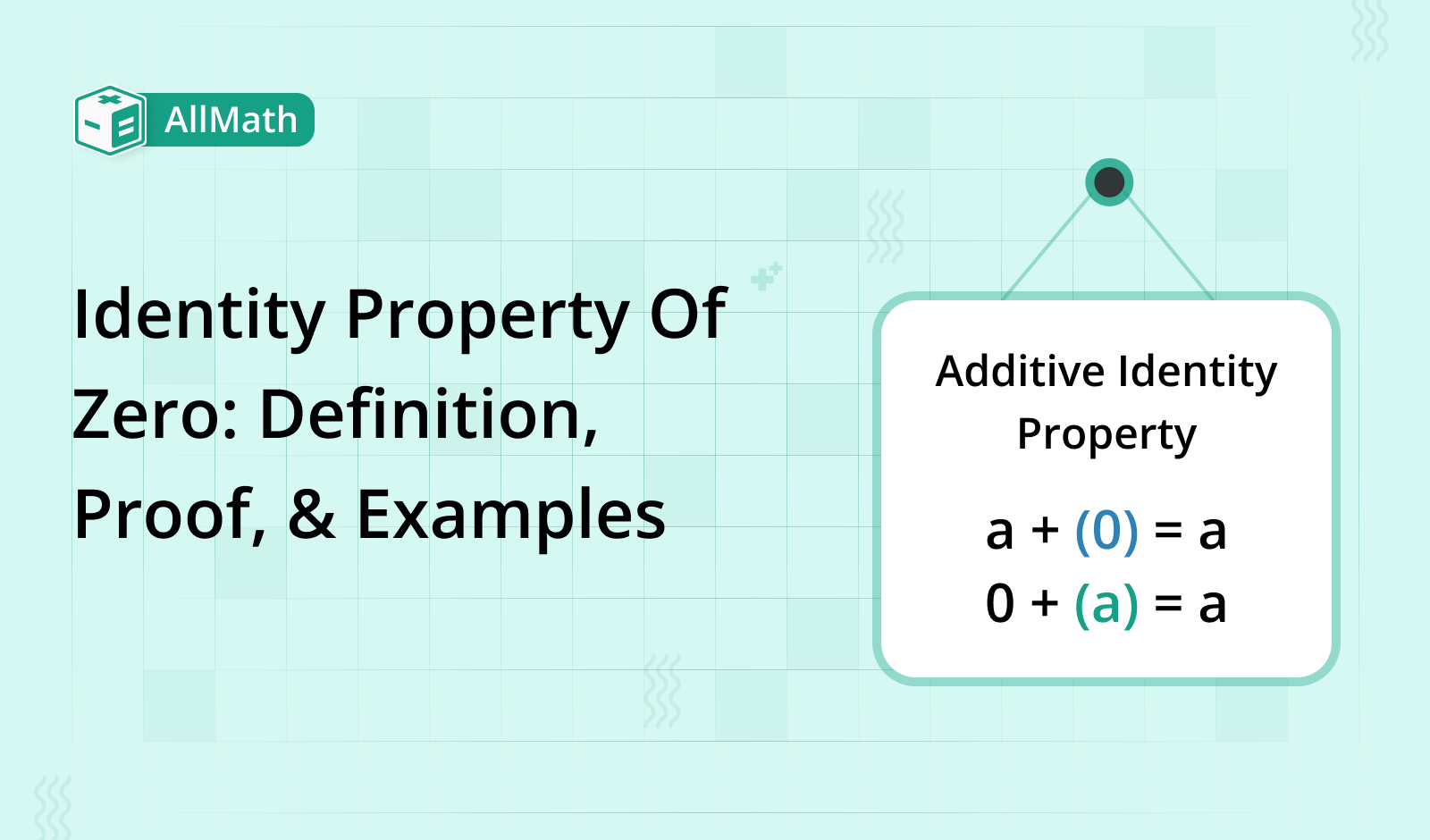To calculate result you have to disable your ad blocker first.
Identity Property of Zero: Definition, Proof, & Examples

Publish Date: 08 Aug, 2023
Table of Content
- 01. Definition of Identity Property of Zero
- 02. Proof of Identity Property of Zero
- 03. Importance of the Identity Property of Zero in Mathematics
- 04. Real-World Examples of the Identity Property of Zero
- 05. Common Misconception about the Identity Property of Zero
- 06. Examples of Identity Property of Zero
- 07. Conclusion
The identity property says that when you combine any number with the identity element for a specific operation, the result stays the same. The identity element is zero for addition. Therefore; the result of adding or subtracting zero from any number is the number itself.
The identity property of zero allows mathematicians and students to manipulate numbers and equations effectively. In this article, we are going to explore the definition of the identity property of zero, its application, and its Examples.
Definition of Identity Property of Zero
The identity property of zero is a specific case of identity property. It says that; if zero is added or subtracted to any number; the result is always the number itself. Mathematically, the identity property of zero can be written as:
- a + 0 = a (Identity property with respect to addition)
- a - 0 = a (Identity property with respect to subtraction)
Where
- ‘’a’’ represent any real number.
Proof of Identity Property of Zero
Assume that we have the real number "a". We want to show that adding zero to “a” does not change its value.
Proof by contradiction:
Suppose there is a number b such that b + 0 ≠ b for some number a. Then, we have b + 0 = c for some number c that is not equal to b. But this means that 0 = c – b, which is a contradiction. A number's value is unaffected by the addition of zero since 0 is the additive identity.
For example, let’s say b = 5 and c = 6. Then b + 0 = 5 + 0 = 5, but c – b = 6 – 5 = 1. This means that 0 cannot change to 1, which is a contradiction.
Therefore, the identity property of zero holds for all numbers.
Importance of the Identity Property of Zero in Mathematics
The identity property of zero has a significant role in various mathematical operations and concepts. Let's explore some of its key importance:
Addition
The identity property of zero allows us to understand that adding zero to any number does not change the value of that number. This property enables us to perform calculations with ease. It simplifies mathematical expressions and makes them more manageable.
Subtraction
The identity property of zero also extends to subtraction. When subtracting zero from any number, the result remains unchanged. This property provides a useful tool in computations and facilitates the simplification of equations.
Algebraic Manipulations
Algebraic manipulations often involve the use of the identity property of zero. It enables mathematicians to manipulate equations and expressions by adding or subtracting zero strategically. This property helps in simplifying equations, solving systems of linear equations, and deriving mathematical proofs.
Matrix Operations
When adding the zero matrix to any given matrix, the result remains the same. This property allows for efficient calculations and simplifications in matrix algebra.
Real-World Examples of the Identity Property of Zero
The Identity Property of Zero appears in many real-world scenarios. Some scenarios are here:
- Consider a bank account with a balance of $500. If no transactions occur, the balance remains unchanged, represented by the Identity Property of Zero.
- Adding zero ounces of water to a glass filled with water results in the same quantity of water.
- Let’s say you have a clock showing the current time as 2:00 PM. The time does not change if you add 0 hours or minutes to the current time.
- If a car is traveling at a constant speed of 60 miles per hour. The addition of 0 miles per hour will not affect the speed.
Common Misconception about the Identity Property of Zero
People often think that the identity property of zero applies to all mathematical operations. The identity property of zero is only for addition and subtraction. It does not hold for multiplication and division.
The identity element is 1 in multiplication. The number multiplied by one will remain the same, but the product of a number by zero will always result in zero instead of the original number. In division, 1 is the identity element. Dividing any number by 1 will yield the same number, but dividing 0 by any non-zero number is undefined.
It is crucial to understand the specific properties and identities that apply to each mathematical operation to avoid misconceptions. While the identity property of zero holds for only addition and subtraction. it is not a universal property that applies to all operations.
Examples of Identity Property of Zero
Example 1.
Find the value of n, if n + 0 = 15
Solution:
In the given equation, n + 0 = 15, we can determine the value of 'n' using the additive identity property.
The additive identity property states that adding zero to any integer does not affect that number's value. The value of n in this equation remains the same as the right-hand side of the equation.
Therefore, n= 15
Example 2.
How many more people must be added to the room to keep the number of people constant?
Solution:
If you want the number of people to remain the same, add 0 people to the room.
Conclusion
In this article, we have discussed the definition of the identity property of zero. We proved that any numbed adding to zero does not change its value. We described its importance in mathematics. Some real-world examples of identity property had been covered in this article.

